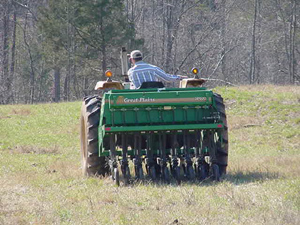Overseeding perennial pastures can help forage and livestock producers by extending their grazing season, cut back on stored hay requirements and also produce high quality forage for their operations. Winter annuals can provide enough energy and protein so they can put weight back on and keep brood cows in good condition before, during, and after calving. So let’s discuss tips for successful establishment of winter annual forages when overseeding into perennial pastures.
Overseeding is not always successful. Most unsuccessful attempts at this production practice is caused by growers not removing excess growth from bahiagrass or bermudagrass before seeding winter annuals. Good seed to soil contact is important, thus removing excess growth by either grazing, mowing or tillage is important. Planting into short sod decreases shading, increases establishment rate and improves early season forage production. In these cases, seedbed preparation will result in better stands and faster early growth of the overseeded crop. Bahiagrass offers more competition to new seedlings than bermudagrass and could require more seedbed preparation. If tillage is used, it is not necessary to penetrate the sod more than 2 to 3 inches. Use of a drag after any tillage will help improve the seedbed and smooth the soil surface. Overseed in the fall when cooler temperatures have slowed the growth of the summer grasses (in October). Seeding too early, when the summer grass is still rapidly growing, usually results in poor stands. Actively-growing summer grasses provide too much competition for the new seedlings.
Another consideration is planting depth of winter annual forages. A great discussion on forage planting depth can be found at the following link. https://site.extension.uga.edu/colquittag/2014/09/ensure-proper-planting-depth-of-your-forages/
Often times I get a comment about which winter annual forage to plant. It all depends on when you need the grazing. The timing of forage availability is primarily affected by the cool season annual species (and, in some cases, variety) that is used, the type of seedbed into which the crops are to be planted, and the planting date. If late fall or early winter grazing is desired, rye or oats should be used. However, if peak forage availability is needed in the spring, annual ryegrass, the annual clovers, and wheat will generally provide more forage during those months. However, sod-seeded cool season annuals are slow-growing in the fall, and the forage is unlikely to achieve a sufficient height for grazing until late December or the end of January.

